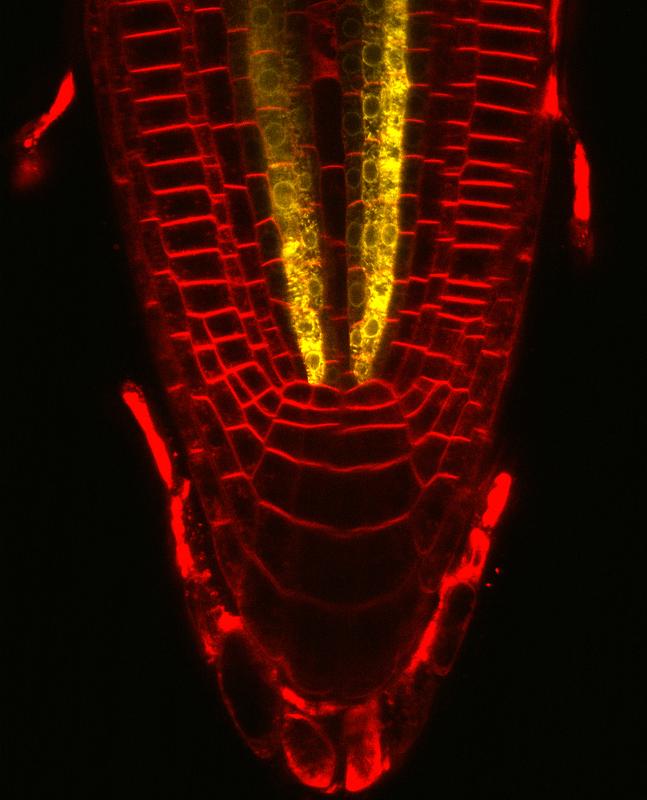How Plants Form Their Sugar Transport Routes

Shown is the activity of the SMXL4 gene (yellow) in very early phloem cells of the root tip of Arabidopsis thaliana. Image: Eva-Sophie Wallner
In experiments on transport tissues in plants, researchers from Heidelberg University were able to identify factors of crucial importance for the formation of the plant tissue known as phloem.
According to Prof. Dr Thomas Greb of the Centre for Organismal Studies (COS), these factors differ from all previously known factors that trigger the specification of cells. The findings of the Heidelberg researchers substantially expand our understanding of the metabolic processes in plants. Their results were published in the journal “Current Biology”.
Phloem, also called bast, is a vascular tissue that runs through all the organs of plants. It transports sugars formed in the leaves during photosynthesis. “In the course of our research on plant development, we discovered three main factors that are critical for the formation of phloem,” states Thomas Greb.
These factors are the proteins SMXL3, SMXL4, and SMXL5. They act in the nuclei of cells that develop into phloem tissue, and from there alter the cells to specialise in transport.
The researcher explains that the factors are similar to others involved in hormonal signal transmission – but they do not react to these hormones. This unresponsiveness is crucial for building robust phloem tissue and therefore for the growth of the plant in general.
“Until now, we understood very little about phloem formation, which is why our results open up new areas of research in a number of ways,” explains the Heidelberg biologist. The researchers hope to gain new insights into the regulation of long-distance transport of sugars and metabolic products.
How plants react to their environment through the formation of bast could also be studied in greater detail. “That gives us vital clues about the evolution of plants,” says Prof. Greb, who directs the Developmental Physiology working group at the COS.
Original publication:
E.S. Wallner et al.: Strigolactone and Karrikin-Independent SMXL Proteins Are Central Regulators of Phloem Formation, Curr Biol 27(8):1241-1247, doi: 10.1016/j.cub.2017.03.014
Contact:
Prof. Dr Thomas Greb
Centre for Organismal Studies (COS)
Phone +49 6221 54-5524
thomas.greb@cos.uni-heidelberg.de
Communications and Marketing
Press Office
Phone +49 6221 54-2311
presse@rektorat.uni-heidelberg.de
Media Contact
All latest news from the category: Life Sciences and Chemistry
Articles and reports from the Life Sciences and chemistry area deal with applied and basic research into modern biology, chemistry and human medicine.
Valuable information can be found on a range of life sciences fields including bacteriology, biochemistry, bionics, bioinformatics, biophysics, biotechnology, genetics, geobotany, human biology, marine biology, microbiology, molecular biology, cellular biology, zoology, bioinorganic chemistry, microchemistry and environmental chemistry.
Newest articles

First-of-its-kind study uses remote sensing to monitor plastic debris in rivers and lakes
Remote sensing creates a cost-effective solution to monitoring plastic pollution. A first-of-its-kind study from researchers at the University of Minnesota Twin Cities shows how remote sensing can help monitor and…

Laser-based artificial neuron mimics nerve cell functions at lightning speed
With a processing speed a billion times faster than nature, chip-based laser neuron could help advance AI tasks such as pattern recognition and sequence prediction. Researchers have developed a laser-based…

Optimising the processing of plastic waste
Just one look in the yellow bin reveals a colourful jumble of different types of plastic. However, the purer and more uniform plastic waste is, the easier it is to…



